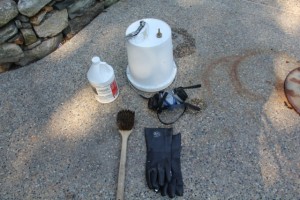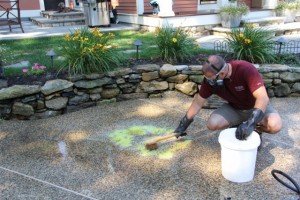How To Remove A Rust Stain Off Concrete Or Bluestone
Techniques and Tips For Cleaning Rust From Concrete
Remove stubborn rust stain fast and easily.
Many homes have concrete and blue-stone walkways, steps and patios. The problem is rust stains can occur from patio furniture, umbrella stands, fire pits or toys. These stains can very difficult to remove.
Detailed below step by step are the necessary functions showing you how to remove a rust stain off concrete or bluestone. It’s EASY to remove a rust stain your concrete or blue-stone driveway, walkway or patio using muriatic acid.
Introduction Video
Safety Information
Do-it-yourselfer’s should avoid muriatic acid where possible. Only use muriatic acid after exhausting other cleaning methods like TSP, or less caustic concrete stain removers.
Muriatic acid is not the first choice for masonry cleaning but the last resort. Do not use this dangerous chemical unless you are sure you have no other choice
Muriatic acid is a highly reactive liquid acid, and one of the most dangerous chemicals you can buy for home use. It is an industrial-strength solution of hydrogen chloride gas dissolved in water, also known as hydrochloric acid.
With the exception of some plastics, muriatic acid can damage most anything it touches, including clothing, metal, and skin! It emits a suffocating odor that can quickly burn the lining of the nose, throat and even the lungs.
Typical home uses include heavy-duty masonry cleaning, preparation of masonry for painting or sealing, removal of efflorescence or mineral deposits and pH reduction in swimming pools.
If you consider using muriatic acid, please heed all safety recommendations both here and on the product’s label.
Muriatic acid must be used with EXTREME CAUTION!!
Contact with the eyes, for example, can cause irreversible damage and permanent blindness. Contact with the skin can cause severe burns.
1) Dress appropriately.
Wear safety glasses, acid-resistant gloves, long sleeves and pants, and use a NIOSH-approved respirator equipped with the appropriate acid-grade filter.
2) Have a neutralizing agent and a reliable, steady source of water available.
Baking soda or garden lime can quickly neutralize the acid if spilled. Water should be freely available in case you accidentally get acid on your skin.
Since muriatic acid can damage or kill foliage, cover or wet all nearby foliage with water before application of the acid
3) Work in an area with adequate ventilation.
Use a fan to bring fresh air to the work area if necessary. Muriatic acid is nonflammable, but the vapors are highly corrosive and irritating.
4) Using muriatic acid indoors is not recommended.
The corrosive vapors can begin chemical reactions in metals, leading to long-term permanent damage!
5) Accidental cleanups… what if you spill muriatic acid?
Spreading a generous quantity of lime (the powdered or crushed type used for lawn or gardens) or baking soda and adding water will cause a distinctive “fizz” as the lime reacts with the acid to produce a harmless salt, water and release carbon dioxide. Garden lime is less expensive than baking soda and is sold in larger bags.
6) Muriatic acid should NEVER be poured down a storm drain, a sink or flushed down a toilet.
Doing so can cause extreme damage to pipes, dissolve solder and damage the biological balance of your septic system. Throwing away even a closed container of muriatic acid with the trash can be dangerous for trash handlers, their trucks and possibly cause unexpected chemical reactions in landfills.
Neutralize your container prior to discarding. Call your local recycling center for more info.
7) If using a sprayer to apply Muriatic acid take precautions to cover nearby objects and vegetation with plastic.
8) Do not use a sprayer on a windy day.
What you will need:
1. Muriatic acid – 1 quart for small areas.
2. NIOSH-approved respirator equipped with the appropriate acid-grade filter
3. Safety glasses
4. Rubber gloves – acid resistant type
5. Garden hose with high pressure nozzle sprayer
6. Lime or baking soda.
7. long handled masonry Scrub brush
If using a sprayer to apply the acid – you will need plastic sheeting to protect surrounding objects.
VIDEO: Getting Started
How to use muriatic acid
Muriatic acid should be diluted to at least 1 part acid to 10 parts water. Mix the acid and water in a plastic container.
Always pour acid into water, never water into acid.
Mixing the two causes a reaction that gives off heat. This reaction is much more sudden and violent when water is poured into acid.
The diluted acid can be applied with a brush or sprayer depending on the circumstances.
If you’re going to spray, it’s best to buy a cheap sprayer and throw it away when finished.
Steps to clean rust Off masonry
- Wet the stain and all of the surrounding area.
- Mix the acid with water 1 part acid to 10 parts water (by volume) is

typical, but dilutions as light as 1 part acid to 16 parts water also work well.
- Note- a 1-16 ratio is 1 cup acid to 1 gallon of water.
- Read the label on the product you buy and follow the recommendations, if any. Remember… add the acid to the water, not water to acid!
- Brush or spray acid onto affected area. Do not use a metal sprayer. A plastic sprayer will work for a while, but will eventually be destroyed by the acid. Have a few extras nearby and throw away used sprayers when finished.
- Let the acid sit for no more than a few minutes, less if you can see the rust lifting.

- Scrub off any remaining residue with a stiff brush while rinsing thoroughly with water. There are long handled masonry brushes ideal for this job.
- Neutralize the acid with lime of baking soda and rinse.
- Rinse again
For stubborn stains:
VIDEO: Follow the safety rules and avoid common errors
Always rinse thoroughly:
You need to be aware that this process may leave your concrete or blue stone looking cleaner than the surrounding area. To minimize this work only the stain and rinse quickly, try to keep a lot of the acid mixture on the concrete surface. The longer it is left on the more it will clean, and possibly etch the surface making it look different.
How to safely dispose of muriatic acid or clean up muriatic acid spills.
- You can also use lime to neutralize leftover muriatic acid. Get a large bucket. I prefer 5-gallon size dangerous since the chance of dangerous spattering is minimized in a large bucket. Put three of four cups of lime in the bottom and a gallon of water. Give it a stir.
- Slowly add the acid to the bucket keeping your face away while pouring (and wearing your respirator).
- Stir, adding more acid and more lime until all chemical “fizzing” has stopped.
- The fully neutralized acid can now be safely disposed down a sink or storm drain without fear of damage to your septic system or the environment.
NOTE: Remember… always add acid to water, not water to acid!!!!
Recycle your left over muriatic acid:
If you know someone who owns a pool you can give them you’re left over muriatic acid. It’s a great pH reducer in pools
Visit my website to find practical solutions to your home improvement challenges.











